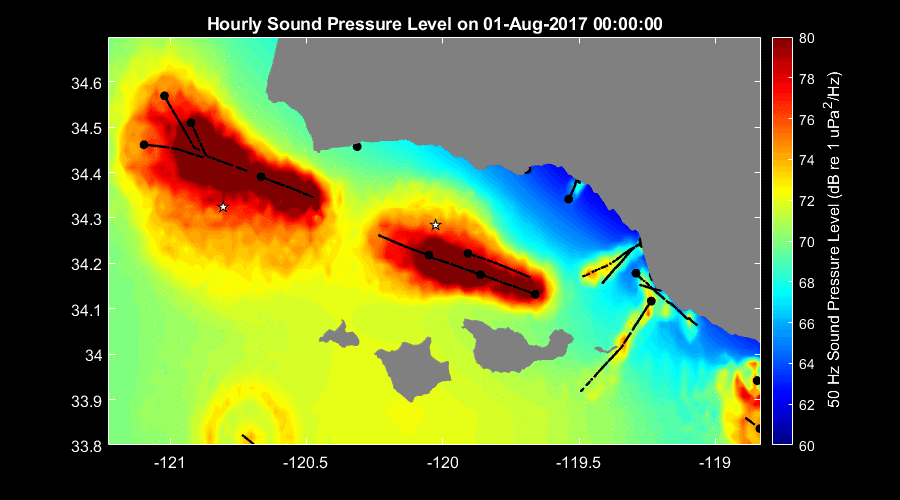The Pacific Ocean waters off Southern California used to be much quieter hundreds of years ago. Then came the Industrial Revolution, commercial shipping and about 15 extra decibels (dB) of noise.
That’s the conclusion of a first-of-its-kind study by researchers from the Marine Physical Laboratory at Scripps Institution of Oceanography at UC San Diego. They created a model of the ocean soundscape as it was experienced by whales, dolphins, and other marine organisms hundreds of years ago. They used as their subject site the Santa Barbara Channel, where heavily trafficked shipping lanes intersect with marine sanctuaries and the foraging ground of endangered blue whales.
“It was surprising to me how quiet the channel was [prior to shipping],” said study lead author Vanessa ZoBell, a postdoctoral researcher in the Scripps Machine Listening Lab. “It’s shielded by islands so it can get really quiet. To see what conditions to which marine organisms were adapted and what they are exposed to today is interesting to look at.”
The scientists compared the natural, pre-industrial sound to models of modern, present-day ocean noise, taking into account the ensemble of natural sounds from wind and the noise from propeller cavitation of cargo ships, cruise liners, and pleasure boats. The soundscape today, they found, is up to 15 dB higher than it used to be before international trade made Los Angeles and Long Beach the busiest shipping ports in the United States. Because dB ranges are logarithmic, that means that it is up to 30 times louder in these waters than it used to be.
“It would be like having a picnic in a meadow versus having a picnic on the side of a busy freeway,” said ZoBell.
The finding matters because noise pollution affects a range of marine organisms, most notably whales who communicate with each other over vast expanses of ocean, provided they are not drowned out by noise pollution from ships. The volume of cargo ship traffic has tripled in the last 30 years and is only expected to increase.

Study results appeared April 20 in the journal Marine Pollution Bulletin.
ZoBell describes the simulation as “computationally expensive,” which explains in part why a comparison like this had not been done before. The researchers said the technically difficult part of the study was in building robust propagation models of how sound spreads, absorbs, and reflects in an underwater environment before petering out. These models were used in depicting present-day sound levels accurately.
ZoBell credited the UC Ship Funds program, a program that awards sea time aboard Scripps research vessels to students, for providing her team the ability to make physical measurements needed as inputs to the model. Sound propagation in the ocean requires knowledge of how sound travels through sediment at the seafloor in addition to through the water column, because those factors can dampen, bend, and reflect sound. The team used the Scripps Oceanography research vessel Robert Gordon Sproul to collect sediment samples in the Santa Barbara Channel to measure how sound spreads through those materials.
The extent of excess noise off the coast and how it changes over space and time serves a valuable purpose, the study concludes, as it “is required for the development of focused and effective management and conservation strategies for marine mammals, fishes, and invertebrates, as these species utilize various regions of the Santa Barbara Channel during different times of the year.”
“So despite not having a time machine to visit the pre-industrial ocean, the study provides a window into ocean sound levels that were typical during the millions of years over which marine organisms evolved,” said Scripps oceanographer John Hildebrand, a study co-author and principal investigator of the Scripps Whale Acoustics Lab.
Scripps biological oceanographer Kait Frasier also co-authored the paper.
Additional support for the work came from the NOAA Dr. Nancy Foster Scholarship, the Office of National Marine Sanctuaries, the Green Family Fellowship, the UC San Diego Science Policy Fellowship, NASA, and the federal Bureau of Ocean and Energy Management.
About Scripps Oceanography
Scripps Institution of Oceanography at the University of California San Diego is one of the world’s most important centers for global earth science research and education. In its second century of discovery, Scripps scientists work to understand and protect the planet, and investigate our oceans, Earth, and atmosphere to find solutions to our greatest environmental challenges. Scripps offers unparalleled education and training for the next generation of scientific and environmental leaders through its undergraduate, master’s and doctoral programs. The institution also operates a fleet of four oceanographic research vessels, and is home to Birch Aquarium at Scripps, the public exploration center that welcomes 500,000 visitors each year.
About UC San Diego
At the University of California San Diego, we embrace a culture of exploration and experimentation. Established in 1960, UC San Diego has been shaped by exceptional scholars who aren’t afraid to look deeper, challenge expectations and redefine conventional wisdom. As one of the top 15 research universities in the world, we are driving innovation and change to advance society, propel economic growth and make our world a better place. Learn more at ucsd.edu.



